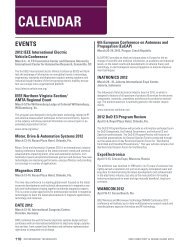2011 EMC Directory & Design Guide - Interference Technology
2011 EMC Directory & Design Guide - Interference Technology
2011 EMC Directory & Design Guide - Interference Technology
Create successful ePaper yourself
Turn your PDF publications into a flip-book with our unique Google optimized e-Paper software.
testing & test equipment<br />
N e w <strong>EMC</strong> Requir e m e n t s F o r C o mm e r c i a l Av i o nic s<br />
New <strong>EMC</strong> Requirements For<br />
Commercial Avionics: RTCA/DO-160G<br />
Erik J. Borgstrom<br />
Environ Laboratories LLC<br />
Bloomington, Minnesota USA<br />
RTCA/DO-160G, Environmental Conditions<br />
and Test Procedures for Airborne<br />
Equipment, prepared by RTCA<br />
Special Committee 135, was issued on Dec.<br />
8, 2010, superseding the previous version,<br />
DO-160F [1].<br />
DO-160G covers standard procedures<br />
and environmental test criteria for testing<br />
airborne electrical and electronic equipment<br />
(avionics). The tests specified in DO-160G<br />
are typically performed to meet Federal<br />
Aviation Administration (FAA) or other<br />
international regulations covering electrical<br />
or electronic equipment that is installed on<br />
commercial aircraft.<br />
The tests and test levels/limits (also referred<br />
to as “Equipment Categories”) found<br />
in DO-160G are applicable to virtually every<br />
type of aircraft in use today, including<br />
small general aviation aircraft, business jets,<br />
helicopters, regional jets, and “Jumbo Jets,”<br />
such as the newest airliners from Airbus (the<br />
A350XWB) and Boeing (the 747-8).<br />
The document includes 26 sections and<br />
three Appendices, but it is Sections 15<br />
through 23 and also Section 25 that cover<br />
<strong>EMC</strong>. Examples of other tests covered in<br />
DO-160G are: temperature, altitude, vibration,<br />
sand/dust, power input, radio frequency<br />
susceptibility, lightning, and electrostatic<br />
discharge.<br />
Creation and revision of DO-160G is<br />
coordinated with the European Union sister<br />
organization to RTCA, EUROCAE. As<br />
a result of this trans-Atlantic cooperation<br />
and joint effort by the two organizations,<br />
RTCA/DO-160G and its European twin,<br />
EUROCAE/ED-14G, are identically worded.<br />
The purpose of this article is to provide<br />
an overview of each of the sections that deal<br />
with <strong>EMC</strong> in DO-160G. Changes in each<br />
section since the release of DO-160F will<br />
be summarized. Finally, we will look at the<br />
future direction of SC-135, and the timetable<br />
for future revisions to DO-160, and the DO-<br />
160 Users <strong>Guide</strong>.<br />
SECTIONS 1-3<br />
The first three sections cover the Purpose<br />
and Applicability (Section 1) of DO-160, provide<br />
a Definition of Terms (Section 2) used<br />
throughout the document, and give Conditions<br />
of Tests (Section 3). These first three<br />
sections are referenced in all of the subsequent<br />
sections of DO-160, and provide the<br />
general information and guidance needed to<br />
properly perform the specified tests.<br />
What’s new for DO-160G?<br />
• In Section 1, a discussion of the Users<br />
<strong>Guide</strong> material found in an appendix after<br />
many sections, and the confirmation that<br />
any information found in the Users <strong>Guide</strong><br />
is GUIDANCE ONLY (emphasis added).<br />
• In Section 2, additional guidance covering<br />
“Category Tests and Declarations”. In<br />
particular, Section 2.8 now states that if<br />
equipment is qualified to a particular category,<br />
the equipment can be considered to<br />
be qualified to any other category that is<br />
less severe.<br />
• In Section 3, additional guidance covering<br />
“EUT Configuration for Susceptibility Tests”,<br />
with special attention given to the firmware<br />
56 interference technology emc <strong>Directory</strong> & design guide <strong>2011</strong>


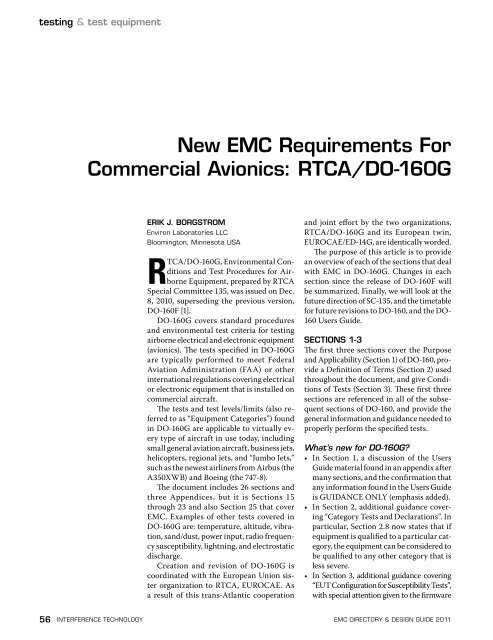

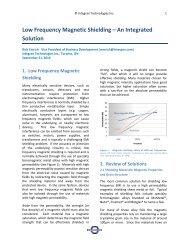

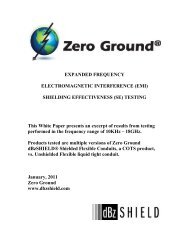
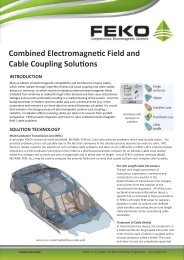

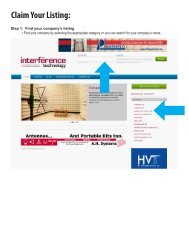

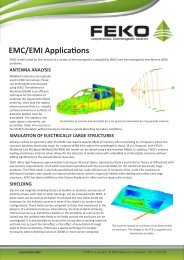
![[ thursday ] morning sessions 8:30 am-noon - Interference Technology](https://img.yumpu.com/23176841/1/190x247/-thursday-morning-sessions-830-am-noon-interference-technology.jpg?quality=85)
